Chapter 18.15
R-1A AND R-1 SINGLE-FAMILY RESIDENCE DISTRICT
Sections:
18.15.010 Use and bulk regulations in all residence districts.
18.15.060 Property development standards.
18.15.070 Outdoor storage of personal property.
18.15.010 Use and bulk regulations in all residence districts.
Use and bulk regulations applying specifically to residences are set forth in this chapter. Also applying to residence districts are additional regulations set forth in other chapters and sections of this title as follows:
(A) HMC 18.05.040, Zoning districts – Establishment and application.
(B) HMC 18.05.050, Rules of interpretation of district boundaries.
(C) HMC 18.05.060, Interpretation and application – Supplementary district regulation.
(D) Article II of Chapter 18.05 HMC, Definitions.
(E) Chapter 18.70 HMC, Planned Unit Development Districts.
(F) Chapter 18.75 HMC, Landscaping Regulations.
(G) Chapter 18.80 HMC, Off-Street Parking and Loading.
(H) Chapter 18.90 HMC, Nonconforming Uses and Nonconforming Buildings.
(I) Chapter 18.110 HMC, Administration.
(J) HMC 18.115.050, Use variances. [Ord. 1659 § 1, 2017].
18.15.020 Purpose.
The purpose of this chapter is to establish two districts in which single-family residential use may take place, and to identify other compatible allowable uses, as well as transitional uses and use variances which may be allowed under certain circumstances and with limitations as identified hereinafter. [Ord. 1659 § 1, 2017].
18.15.030 Permitted uses.
The following listed uses and no others are permitted uses in R-1A and R-1 districts:
(A) Residential uses as follows:
(1) One-family detached dwellings, including models.
(2) Planned unit developments, residential as set forth in Chapter 18.70 HMC, including models.
(B) Community service uses as follows:
(1) Churches, rectories and parish houses, not to exceed 15,000 square feet in aggregate area.
(2) Parks, playgrounds, community centers, and other recreational uses publicly or privately owned and operated, and less than three acres in size.
(3) Community gardens; provided, that:
(a) The maximum area of the garden shall be the lesser of 22,500 square feet in area, or three contiguous lots.
(b) No two community gardens may be located within one mile of each other.
(4) Public and parochial schools, and ancillary buildings.
(5) Public electric, gas, water, and telephone facilities.
(6) Public libraries.
(C) Miscellaneous uses as follows:
(1) Temporary real estate offices in conjunction with a new housing or subdivision development, limited to the selling or renting of new units in such developments and in no case to be operated for more than one year following the completion of construction of such housing development. The building commissioner shall have the authority to grant reasonable extensions to this time limit.
(D) Uses incidental to principal permitted uses as follows:
(1) Accessory uses, as set forth in HMC 18.05.060(F)(5).
(2) Home occupations, as defined in HMC 18.05.150.
(3) Signs as permitted in Chapter 18.85 HMC.
(4) Temporary buildings for construction purposes, for a period of time not to exceed the duration of such construction.
(5) Sale of personal property owned by the occupant of a residence located on the same property as defined in HMC 18.05.140, definition of “Garage sales.”
(E) Nonconforming Uses. Requirements relating to nonconforming lots, uses, and structures in the residential districts are set forth in Chapter 18.90 HMC.
(F) Short-Term Rental Housing. Short-term rental housing shall not be permitted in these zoning districts. [Ord. 1659 § 1, 2017].
18.15.040 Transitional uses.
In R-1A and R-1 districts, the following uses are permitted when located on a lot not over 300 feet in width measured along said lot’s frontage, which adjoins at a side or rear lot line or is separated only by an alley or public easement at a side lot line from property in a business or industrial district.
(A) Principal offices of professional persons for the practice of medicine, law, dentistry, architecture, engineering, and similar professions; provided, that each such office is situated in the same dwelling unit as the home of the occupant, with not more than two persons other than members of the occupants’ immediate family being employed thereby. The residential character of the exterior of the building shall be entirely maintained except for permitted accessory signs as provided for in Chapter 18.80 HMC. [Ord. 1659 § 1, 2017].
18.15.050 Use variances.
In R-1A and R-1 districts, use variances may be allowed only in accordance with the limiting conditions and procedures as set forth in HMC 18.115.050. [Ord. 1659 § 1, 2017].
18.15.060 Property development standards.
(A) Minimum Lot Size in an R-1A Residence District. Minimum lot size requirements for an R-1A district are as follows:
(1) Every one-family detached dwelling hereafter erected and every transitional use permitted in this zoning district hereafter established shall be on a zoning lot having a minimum area of 10,000 square feet and a minimum width of 80 feet at the building line, and a lot depth of 125 feet. A lot of record existing on the effective date of the ordinance codified in this title which is less than 10,000 square feet in area or less than 80 feet in width, or 125 feet in depth, may only be improved by a variance from the board of zoning appeals.
(a) However, when such lot of record is less than 50 feet in width at the building line, and is in the same ownership on or after the effective date of the ordinance codified in this title, and has an adjoining unimproved lot on the same street, it shall not be improved with a residential use unless both lots are combined as a single zoning lot for this purpose or unless further resubdivision produces the requisite 80-foot minimum lot width.
(2) The maximum lot depth for all residential lots in this district shall not exceed twice the width of the lot, but in no case more than 150 feet.
(3) Other, nonresidential permitted uses listed in this district hereafter established shall be on a zoning lot having a minimum area of 10,000 square feet and a minimum lot width of 80 feet at the building line.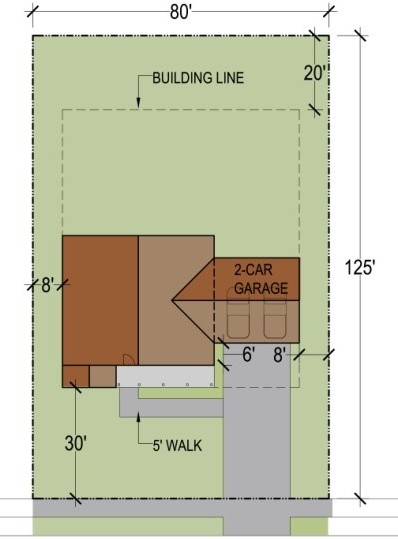
Exhibit 2 – R-1A with Attached
Garage Example
(B) Minimum Floor Area in an R-1A Residence District. No dwelling may be established, erected or changed so that its floor area exclusive of basements, terraces, unenclosed porches and garages in square feet is less than prescribed below.
|
One Story |
1,500 square feet |
|
Two Story |
2,000 square feet (first floor minimum: 1,200 square feet) |
|
Tri-/Bi-Level |
1,800 square feet (first floor minimum: 1,200 square feet) |
(C) Minimum Lot Size in an R-1 Residence District. Minimum lot size requirements for an R-1 district are as follows:
(1) Every one-family detached dwelling hereafter erected and every transitional use permitted in this zoning district hereafter established shall be on a zoning lot having a minimum area of 7,200 square feet and a minimum width of 60 feet at the building line, and a minimum lot depth of 120 feet. A lot of record existing on the effective date of the ordinance codified in this title which is less than 7,200 square feet in area or less than 60 feet in width, or 120 feet in depth, may only be improved by a variance from the board of zoning appeals.
(a) However, when such lot of record is less than 50 feet in width at the building line, and is in the same ownership on or after the effective date of the ordinance codified in this title and has an adjoining unimproved lot on the same street, it shall not be improved with a residential use unless both lots are combined as a single zoning lot for this purpose or unless further resubdivision produces the requisite 60-foot minimum lot width.
(2) The regulations governing nonresidential permitted uses minimum lot size as set forth in subsection (A)(3) of this section shall apply.
(3) The regulations governing use variances minimum lot size as set forth in subsection (A)(1) of this section shall apply.
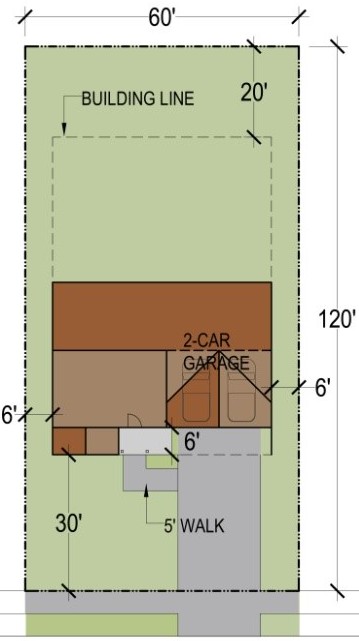
Exhibit 3 – R-1 with Attached Garage Example
(D) Minimum Floor Area in an R-1 Residence District. No dwelling may be established, erected or changed so that its floor area, exclusive of basements, terraces, unenclosed porches, and garages in square feet is less than prescribed below.
|
One Story |
1,200 square feet |
|
Two Story |
1,400 square feet (first floor minimum: 1,000 square feet) |
|
Tri-/Bi-Level |
1,300 square feet (first floor minimum: 1,000 square feet) |
(E) Accessory Buildings in R-1A and R-1 Residence Districts. In R-1A and R-1 districts, all accessory buildings, excluding garages, shall not exceed a floor area of 120 square feet, and only one structure as outlined shall be permitted per dwelling unit. Such accessory building shall not exceed 10 feet by 12 feet in size.
(F) Maximum Floor Area Ratio in R-1A and R-1 Residence Districts. In R-1A and R-1 districts, the floor area ratio of all buildings and structures on a zoning lot shall not exceed 0.5.
(G) Maximum Lot Coverage in R-1A and R-1 Residence Districts. In R-1A and R-1 districts, the maximum lot coverage on a zoning lot shall not exceed 35 percent.
(H) Minimum Landscape Coverage in R-1A and R-1 Residence Districts. In R-1A and R-1 districts, a minimum of 35 percent of the lot area shall include landscaping that conforms to Chapter 18.75 HMC.
(I) Minimum Front Yards in R-1A and R-1 Residence Districts. Minimum front yard requirements for R-1A and R-1 districts are as follows:
(1) On every zoning lot a front yard shall be provided. Such front yard is determined by the front of the residence, and cannot be altered once determined. In no case shall such front yard be less in depth than 30 feet in an R-1A district and R-1 district. The required minimum front yard shall be extended, but not more than 50 feet where lots comprising 40 percent of the frontage on the same street and within the same block are developed with buildings having front yards greater than the setback requirement, and with a variation of not more than 10 feet deep. The average of such front yards shall establish the minimum front yard depth for the entire frontage of such street within the same block.
(2) Required front yards shall be unobstructed from ground level to sky except as otherwise provided in HMC 18.05.060(G)(5).
(J) Minimum Side Yards in R-1A and R-1 Residence Districts. Minimum side yard requirements for R-1A and R-1 districts are as follows:
(1) One-Family Detached Dwellings. On a lot improved with a one-family detached dwelling, a side yard shall be provided along each side lot line. The minimum aggregate width of the side lots shall be 20 percent of the lot width, but with no single side yard being less than eight feet in width in an R-1A district, and six feet in an R-1 district.
(2) On any lot, in any side yard not abutting the street, a detached garage may be erected and maintained within the rear quarter of the lot if not closer to the side lot line than three feet.
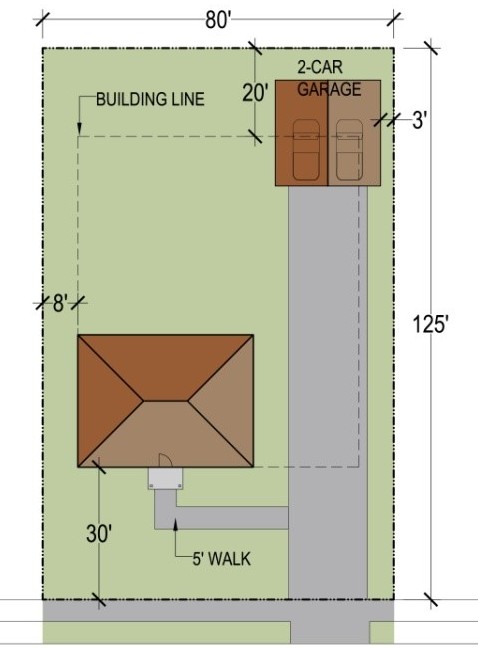
Exhibit 4 – R-1A with Detached
Garage Example
(3) Reversed Corner Lots. On a reversed corner lot the side yard adjacent to the street shall be the same width as the front lot depth of the adjoining lot.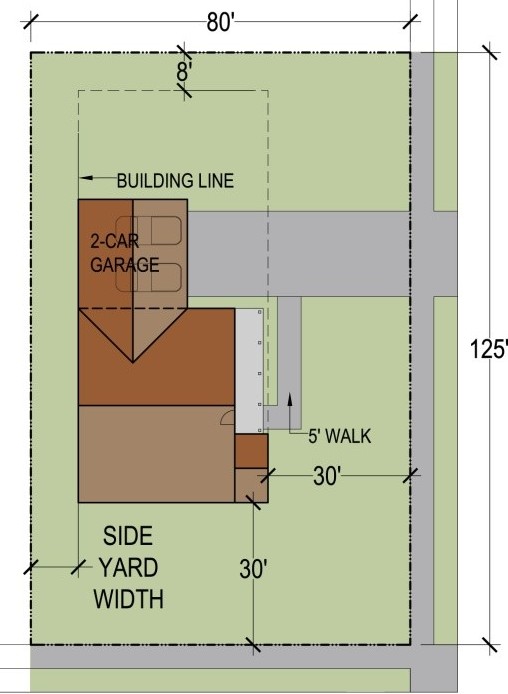
Exhibit 5 – R-1A Reversed Corner Lot Example
(4) Required Side Yards. Required side yards shall be unobstructed from ground level to sky, except as otherwise provided in HMC 18.05.060(G)(5), and except for privacy screens not over six feet above the average level of the adjoining ground. Such privacy screens shall begin not nearer than five feet from the front of the house and may extend not more than five feet beyond the rear of the house.
(K) Minimum Rear Yards in R-1A and R-1 Residence Districts. Minimum rear yard requirements in R-1A and R-1 districts are as follows:
(1) On every zoning lot, a rear yard shall be provided. Such rear yard shall be not less in depth than two-thirds of the building height, but in no case less than 20 feet.
(2) Required rear yards shall be unobstructed from ground level to sky, except as otherwise provided in HMC 18.05.060(G)(5).
(3) Required Rear Yards on Reversed Corner Lots. When the residence faces the long lot dimension, and the required rear yard abuts the neighboring side yard, the required rear yard shall be treated as a side yard.
(L) Additional Yard Requirements. All lots that are undeveloped or unimproved at the time of the passing of the ordinance codified in this title, and are adjacent to an active railroad right-of-way on at least one side, shall have a minimum 50-foot easement on all yards abutting the active railroad.
(M) Maximum Building Height in R-1A and R-1 Residential Districts. The maximum building height permitted in an R-1A and R-1 residential district is 35 feet. [Ord. 1659 § 1, 2017].
18.15.070 Outdoor storage of personal property.
(A) Generally. No personal property shall be stored, maintained, or permitted outside an enclosed building, garage, or carport in an R-1A and R-1 single-family residence district, except as provided in this section.
(B) No more than one recreational vehicle, motor home, camper, trailer, boat or boat trailer, or similar item of personal property may be located in a rear yard. Said personal property must be placed on a hard surface (concrete or bituminous), and screened from neighboring properties by an opaque fence and/or landscaping to a height of six feet above the average grade of the ground upon which the personal property is resting. Said personal property must be owned by the persons who reside on the lot on which they are stored.
(C) Prohibited Areas. Such personal property shall not be stored, maintained or permitted on or within the area of the lot reserved for front yards as applied to the actual dwelling thereon, and for these purposes a side yard facing a public street shall be considered as a front yard for a depth of 50 feet.
(D) Accessory buildings such as storage sheds, playhouses, and the like shall not be stored, maintained or permitted on or within the area of the lot reserved for front yards as applied to the actual dwelling thereon, and for these purposes a side yard facing a public street shall be considered as a front yard for a depth of 50 feet.
(E) Such personal property which may be stored, maintained and permitted on a lot under the provisions set forth in this section shall not be inhabited at any time.
(F) No more than one recreational vehicle, motor home, camper, trailer, boat, or similar item of personal property may be temporarily parked in the front or side yard, outside of a totally enclosed structure and unscreened, for a maximum of 48 hours, in any consecutive 30-day period, for the purpose of loading, unloading, or servicing. Said temporary parking is permitted only if said property is located on the driveway. [Ord. 1659 § 1, 2017].
18.15.080 Design standards.
The following standards shall apply to all new residential uses or major reconstruction of an existing residential use. It should be noted that none of the required provisions is aimed to reduce creativity or impede the architectural design process. Rather, the goal is to encourage creativity and better diversity in the built environment.
(A) No single-family structure may exceed two stories in height.
(B) The primary facade of each home shall face a public street. In the case of a corner building or lot, the facade where the main entrance of the building is located shall be considered the primary facade.
(C) The primary facade of residential buildings must be articulated. Articulation may take the form of staggering the wall of the building as well as through porches, bay or bow windows and balconies. The primary facade must include at least two of the following architectural elements. Any other street-facing facade must include at least one of the following architectural elements:
(1) Porches. Minimum six-foot projection.
(2) Second-story balconies. Minimum five-foot projection.
(3) Roof overhangs. Minimum one-foot projection.
(4) Bay or bow windows.
(5) Cantilevered windows.
(6) Chimney breasts.
(7) Stone accent pieces.
(8) Pediments over windows and doors.
The elements shall be incorporated into the design of the buildings so that they are compatible with the building’s architectural style and also harmonious with the architecture and scale of the neighborhood.
(D) Entry Porches. Entry porches, if provided, must be located either along the front or side facade, at the main entrance, and shall meet the following standards:
(1) Depth. Each porch must be a minimum of six feet in depth.
(2) Length. Each porch must extend a minimum of 50 percent of the length of the facade on which it is located, excluding any portion of the facade that is occupied by a garage.
(3) Enclosure. No portion of the porch may be enclosed by walls or screens. Each porch must be covered with a roof that is integrated into the design of the structure.
(E) Roof Pitch. A variety of roof pitches are encouraged, but no portion of the primary roof of the dwelling may be less than 4:12 (rise:run). In no instance shall this criterion be interpreted as requiring every dwelling’s roof pitch to be 4:12.
(F) Fenestration. Windows shall be incorporated into all facades covering at least 15 percent of each wall.
(G) Primary building facade must be constructed primarily of brick or stone or similar masonry materials. High-quality accent materials, such as cedar siding and vinyl siding (0.044 minimum thickness), may be incorporated into the design; provided, that they do not cumulatively cover more than 50 percent of the primary facade.
(H) If used, vinyl siding shall be premium grade vinyl siding and shall have a minimum thickness of 0.044 inches and shall comply with the ASTM (American Society for Testing and Materials) standard specification for rigid poly siding (ASTM D3679). All siding shall be Class I as listed in this standard.
(I) Where two wall materials are combined horizontally on one facade, the heavier material must be below.
(J) Mechanical equipment or other utility hardware on roof, ground, or buildings shall be screened from public view with materials harmonious with the building, or they shall be so located as not to be visible from any public streets.
(K) Single-family residential garages shall be designed so as not to dominate the primary facade of the building. Garages may be located as follows:
(1) Garages shall be set back six feet from the primary facade of the building.
(2) No more than two cars may be housed or accessible to a front loaded garage in a single-family dwelling.
(3) Side loaded garages shall have windows along the primary facade and other elements to give a uniform appearance with the rest of the dwelling.
(4) Garages which are intended to shelter more than two cars shall be side or rear loaded and may be accessed from the front or rear yards, except that on corner lots, such garages shall be accessible from the side or rear yard.
(5) Garages shall be limited to a maximum of 720 square feet.
(6) Garages shall be limited to a maximum nine-foot door height.
(7) The aggregate total of garage door width in the front-most facade of a building shall be limited to 18 feet. Garages that are side or rear loaded may have a maximum aggregate garage door width of 27 feet; provided, that, for garages facing a public street, at least one garage door is recessed a minimum of five feet behind the other garage doors.
(L) Residential garages for duplexes and multifamily units shall be limited to two garage bays fronting the street. Additional garage bays may be provided in accordance with the provisions of this section. All other residential garage standards shall be as prescribed in this section.
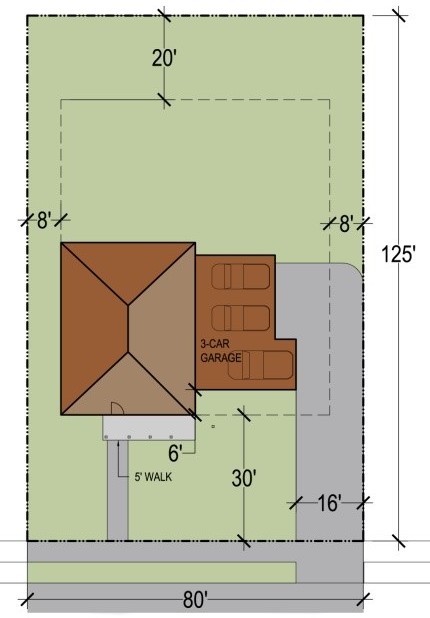
Exhibit 6 – R-1 with Three-Car
Garage Example
(M) Wherever a residential lot abuts an alley along the rear lot line, a detached garage may be built in the rear yard of that lot; provided, that the garage setback is no further than 20 feet from the rear lot line, and vehicular access to the garage is provided from the alley only.
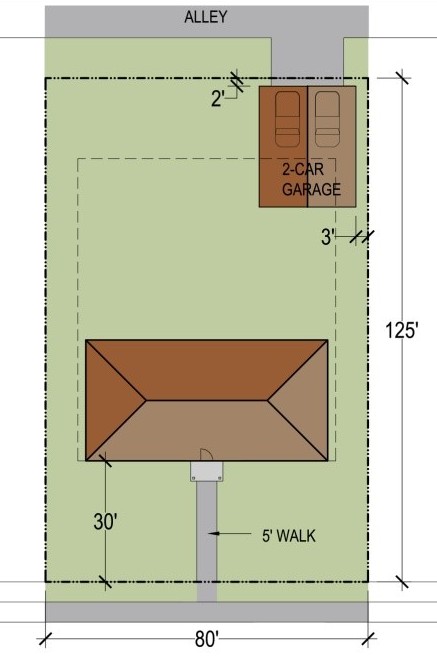
Exhibit 7 – R-1A with Rear-Yard
Garage Example
(N) Where a residential dwelling abuts a street or a less intense residential zoning district, a minimum of 50 percent of the first floor on all faces of the building visible from the street or adjoining the less intense residential district, exclusive of windows and doorways, shall be masonry.
(O) Residential drives shall be constructed of concrete or concrete/masonry paver materials.
(P) In order to facilitate creative streetscapes, each residential subdivision shall institute within its covenants a monotony code for single-family housing. Such monotony code shall set forth the standards for separation of similar building facades and/or building colors so that a variety of housing styles is apparent from any point within the neighborhood.
(Q) The lot shall be planned to accomplish a desirable transition with the streetscape and to provide for adequate planting, safe pedestrian movement, and parking areas.
(R) Landscaping. All front yards must be sodded with approved grass mix and contain at least two trees. Front yard trees shall be at least two inches diameter measured three feet above the ground level and must be chosen from the town’s approved list of trees for streets and front yards. All areas between fences and curbs on corner lots must be sodded as aforesaid.
(S) Fences. The construction of fences on any lot proposed for single-family or duplex residential use shall be of wood, vinyl, ornamental metal, or masonry construction, or a combination thereof. Fence height shall not exceed six feet in the back and side yards, and three feet on front yard. Chain link and concrete block fences shall not be permitted. [Ord. 1659 § 1, 2017].


